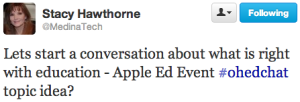Yesterday my Blended Learning Rhetoric and Composition students organized a community event to record a video for the Medina County Stomp out Suicide Project. They have been planning this particular scene for at least a month. This means that I haven't had any sleep for at least a month. Let me backtrack a bit. . .
One day my students and I were discussing possible research projects when I came upon an online flyer for the Stomp out Suicide Video Project. "Hey, do you want to make a video for this contest?" I asked. "You could win a thousand bucks." The students jumped all over it, but in the way that seventeen year olds think about how cool it would be to make a video without doing any of the work to make a video. We downloaded the information and the students half-heartedly discussed ideas.
That day the unthinkable happened: our school lost one of our own to suicide. That evening, one of my students emailed me. "This just got very real for all of us, " she wrote. "We need to get serious and do something to make a difference." And so they did.
The students created storyboards, recruited two videographers, and started shooting. They researched statistics. They assigned responsibilities. One idea they all agreed on was that they needed a community crowd scene. "Our theme is 'You are not alone,'" they said, "so we need to show that nobody is alone. We need the community." They created a Twitter hashtag (#MedinaStrong). They created waivers and flyers.

I watched with pride (and honestly, a whole lot of angst) while my students made appointments with administrators, safety forces, business owners, students, and community members. "Beth," a student who had always been a bit shy and quiet, volunteered to meet with our school's administrators and book the high school stadium and the gymnasium, in case of inclement weather. "John," another student who previously hadn't been much of a go-getter, managed to secure free pizzas, pop, and all the napkins and cups we needed for a large crowd. He also volunteered to plug our video on the school's morning video announcements. My students wrote invitations to school board members and our communications director. They papered our hallways with posters.
What was my role? I tried to stay the hell out of their way. I bit my tongue. . . a lot. I showed them how to log their "business meetings" and all the documentation for the video into a wiki on Blackboard. I retweeted them. I took pictures. . .and I held my breath.
Yesterday, I watched my students organize a crowd of ninety students, EMT's, police officers, and community members into a meaningful event. They presented an opening ceremony, they directed all of those people, and they sent them away feeling that they contributed to something important in the community. Oh, and they collected money through wristband sales to donate to the Battered Women's Shelter of Medina. Here are two newspaper articles describing that day:
"Video: Teens, think twice about suicide" from the Medina County Gazette
"Medina High School students create suicide prevention video" from Cleveland.com
In my last post, I described my job as a shepherd dog. In this particular case, I learned how a blended learning class is really supposed to work. My students were inquisitive, and they were willing to do the work. I was lucky enough to point a finger and gently nudge them from time to time. When I can take a moment to exhale (we aren't finished with the editing process of the video), I will be able to reflect on how this project helped the students ( and me) to learn and grow. More importantly, I will allow the students to reflect on their learning. I want them to tell me what they learned, not just for the sake of the Common Core Standards, but to give them the opportunity to realize what a fabulous moment they shared. This is something I will remember forever, and I certainly believe they will, too.
[caption id="attachment_282" align="alignnone" width="300"]
 You are not alone. Photo: Sydney Campbell[/caption]
You are not alone. Photo: Sydney Campbell[/caption]Stephani Itibrout
Want to read more about Blended Learning? Follow me on Twitter @itibrout

 This is EXACTLY how I look when I'm herding ducks. Or teaching wikis.[/caption]
This is EXACTLY how I look when I'm herding ducks. Or teaching wikis.[/caption]
 Invisible Man in his apartment with stolen light.
Invisible Man in his apartment with stolen light.



 conference. As I look back over my summer, I started to reflect on the real value of attending professional conferences. Sure I got to visit some neat locales, but I was also away from the office (meaning more work to catch up on) and I missed some valuable summertime with my family (kids are in college so the summers are fleeting). Of course, I attended some really interesting sessions and keynotes, but now I have pages of notes (digitally) to sort through and decide how best to integrate in my real life. But neither the change of scenery nor the sessions are what I carry with me everyday as a reminder of my conference experience...
conference. As I look back over my summer, I started to reflect on the real value of attending professional conferences. Sure I got to visit some neat locales, but I was also away from the office (meaning more work to catch up on) and I missed some valuable summertime with my family (kids are in college so the summers are fleeting). Of course, I attended some really interesting sessions and keynotes, but now I have pages of notes (digitally) to sort through and decide how best to integrate in my real life. But neither the change of scenery nor the sessions are what I carry with me everyday as a reminder of my conference experience...













 Earlier this week, I tweeted that we should focus more on what is good in education instead of what is wrong with education. Little did I know when I sent that tweet that I would be challenged to write a blog post on my thoughts. But it is this exact challenge that is central to what is good in education. We all know teachers who come to school every day to challenge and inspire students. They put aside the politics, the testing, the outside pressures, and choose to challenge and inspire students to become lifelong learners. If you know a teacher like this, and I suspect that you do, today would be a great day to let them know that they are central to what is right in education today.
Earlier this week, I tweeted that we should focus more on what is good in education instead of what is wrong with education. Little did I know when I sent that tweet that I would be challenged to write a blog post on my thoughts. But it is this exact challenge that is central to what is good in education. We all know teachers who come to school every day to challenge and inspire students. They put aside the politics, the testing, the outside pressures, and choose to challenge and inspire students to become lifelong learners. If you know a teacher like this, and I suspect that you do, today would be a great day to let them know that they are central to what is right in education today.